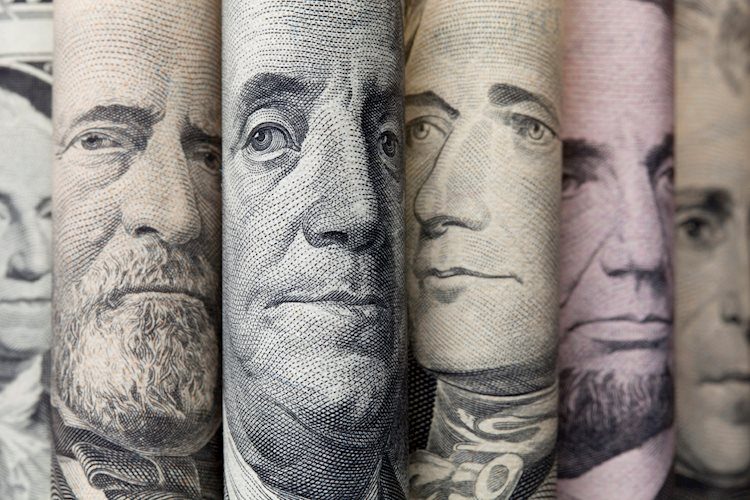- The US Dollar faces selling pressure as investors await fresh catalyst.
- Dovish bets on the Fed and lower US yields weakened the green currency.
- The US will release the preliminary estimate of Q3 GDP and PCE inflation data this week.
The US Dollar (USD) measured by the US Dollar Index (DXY) declined to the 105.75 area and consolidated below the 20-day Simple Moving Average (SMA) on Monday. Falling US Treasury yields leaves markets betting on lower odds of a hike by the Federal Reserve (Fed) and has the US Dollar losing interest.
The latest data from the United States economy suggests that the economic activity is strong. On Thursday, the US will reveal the preliminary estimate of the Q3 Gross Domestic Product (GDP), and on Friday the headline and core measures of the Personal Consumption Expenditures (PCE) from September will be released. The latter is the Fed’s preferred gauge of inflation. In line with that, both data points will give a clearer outlook of the US economy and may play a big role with the modeling of expectations for the nextFed decisions on November 1 and in December.
Daily Digest Market Movers: US Dollar softens ahead of PCE and GDP data
- The US Dollar Index declined to 105.75 at the time of writing, down by nearly 0.40%.
- There won’t be any relevant highlights on the economic calendar on Monday, so focus shifts to high-tier economic figures to be released later this week.
- Q3 Gross Domestic Product is expected to have accelerated.
- Core PCE Price Index on Friday is expected to come in at 3.7% YoY from the previous 3.9%.
- In the meantime, US Treasury yields are falling with the 2, 5 and 10-year rates falling to 5.07%, 4.82% and 4.86%, respectively.
- According to the CME FedWatch Tool, the odds of a 25 bps hike at the December meeting remain low, near 30%.
Technical Analysis: US Dollar Index’s struggle to gather momentum capped by the 20-day SMA
Considering the daily chart, the DXY Index shows a neutral-to-bearish technical outlook for the short term. The Relative Strength Index (RSI), positioned below its midline with a southward slope, supports this view along with the negative indication from the Moving Average Convergence Divergence (MACD), which displays red bars pointing toward a strengthening bearish trend. Additionally, the pair is consolidating below the 20-day Simple Moving Average (SMA), and in case the bulls fail to recover above it, more downside is on the horizon.
The DXY has had a strong run higher, with 11 consecutive up weeks in a row before peaking and forming a bearish Doji/Shooting Star candlestick in the first week of October. DXY did not follow through to the downside, however, with the following week closing higher. Still, it is a warning sign of potential weakness on the horizon.
Supports: 105.70, 105.50, 105.30.
Resistances:106.33 (20-day SMA),106.50, 107.00.
US Dollar FAQs
The US Dollar (USD) is the official currency of the United States of America, and the ‘de facto’ currency of a significant number of other countries where it is found in circulation alongside local notes. It is the most heavily traded currency in the world, accounting for over 88% of all global foreign exchange turnover, or an average of $6.6 trillion in transactions per day, according to data from 2022.
Following the second world war, the USD took over from the British Pound as the world’s reserve currency. For most of its history, the US Dollar was backed by Gold, until the Bretton Woods Agreement in 1971 when the Gold Standard went away.
The most important single factor impacting on the value of the US Dollar is monetary policy, which is shaped by the Federal Reserve (Fed). The Fed has two mandates: to achieve price stability (control inflation) and foster full employment. Its primary tool to achieve these two goals is by adjusting interest rates.
When prices are rising too quickly and inflation is above the Fed’s 2% target, the Fed will raise rates, which helps the USD value. When inflation falls below 2% or the Unemployment Rate is too high, the Fed may lower interest rates, which weighs on the Greenback.
In extreme situations, the Federal Reserve can also print more Dollars and enact quantitative easing (QE). QE is the process by which the Fed substantially increases the flow of credit in a stuck financial system.
It is a non-standard policy measure used when credit has dried up because banks will not lend to each other (out of the fear of counterparty default). It is a last resort when simply lowering interest rates is unlikely to achieve the necessary result. It was the Fed’s weapon of choice to combat the credit crunch that occurred during the Great Financial Crisis in 2008. It involves the Fed printing more Dollars and using them to buy US government bonds predominantly from financial institutions. QE usually leads to a weaker US Dollar.
Quantitative tightening (QT) is the reverse process whereby the Federal Reserve stops buying bonds from financial institutions and does not reinvest the principal from the bonds it holds maturing in new purchases. It is usually positive for the US Dollar.
